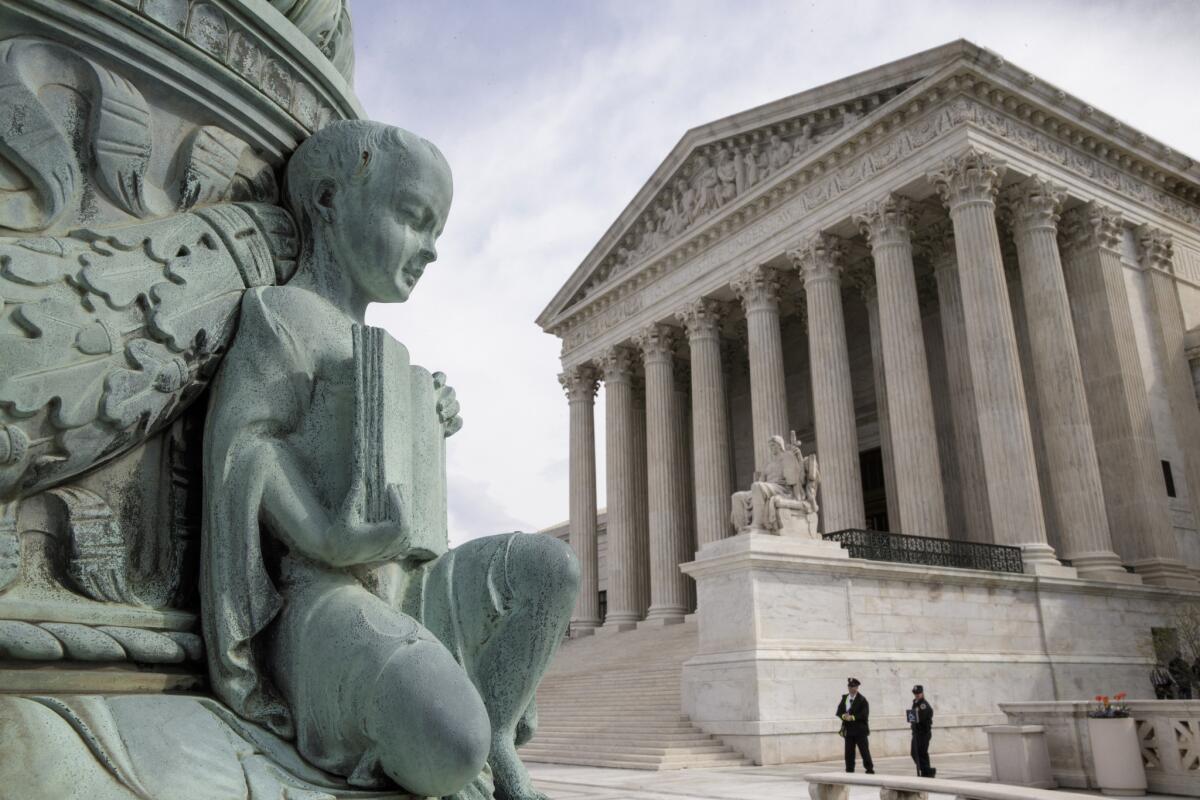Editorial: Supreme Court ruling guarantees kids and noncitizens count too

A cherub holding an open book adorns a flagpole on the plaza of the Supreme Court in Washington, D.C. The justices ruled on Monday in a case involving the constitutional principle of “one person, one vote.”
In a decision that is especially good news for areas such as Southern California with large numbers of noncitizens, the Supreme Court on Monday unanimously upheld the nearly universal practice of drawing legislative districts on the basis of the total population, rather than the number of eligible voters.
The decision was a defeat for two Texas voters, backed by a conservative legal group, who claimed that Texas violated the principle of “one person, one vote” when it created state Senate districts based on total population rather than eligible voters. By counting everyone in drawing district lines, the argument went, Texas created a situation in which some voters had more influence in state affairs than others. That amounted to unconstitutional “debasement” of some votes.
All eight sitting justices [agreed] that Texas’ practice of counting all persons doesn’t violate “one person, one vote.”
It was an ingenious argument. When the court established the “one person, one vote” principle in a 1964 decision — saying that districts had to have approximately equal populations — it wasn’t clear about whether states had to count all inhabitants or could limit the count to eligible voters. The court in that case said that “the overriding objective must be substantial equality of population among the various districts,” but it also said the purpose of districts with equal populations was to guarantee that “the vote of any citizen is approximately equal in weight to that of any other citizen in the state.” The latter observation emboldened the plaintiffs in this case to argue that states must count eligible voters.
All eight sitting justices rejected that contention, agreeing that Texas’ practice of counting all persons doesn’t violate “one person, one vote.” The court didn’t have to reach the hypothetical question of whether a state could choose to count only eligible voters, but Justice Ruth Bader Ginsburg’s majority opinion — signed by five of her colleagues — analyzed the issue in a way that gives little comfort to those who would press for a change.
First, Ginsburg drew a parallel between representation in state legislatures and representation in the U.S. House of Representatives. At the time of the founding of the nation, she observed, representation in the House was based on the number of inhabitants (with the immoral proviso that slaves were counted as three-fifths of a person). After the Civil War, she added, the 14th Amendment made clear that representatives “shall be apportioned among the several States according to their respective numbers.”
Second, Ginsburg recognized that counting all inhabitants reflected an important constitutional principle: that representatives serve the interests of the whole community, not just voters. She quoted Alexander Hamilton, who said: “There can be no truer principle than this — that every individual of the community at large has an equal right to the protection of government.”
That principle has a special significance at a time when many of the people who depend on government services and the advocacy of elected officials aren’t able to vote. That group includes not only people in the country illegally but also permanent legal residents, as well as children and felons who have lost their voting rights. For example, an estimated 755,000 residents of Los Angeles County are legal permanent residents who have not applied to be citizens. If the state drew district lines to reflect only eligible voters, those residents might find themselves in larger legislative districts with less accountable representatives.
Ideally the millions of noncitizens living in this country — legally and illegally — would obtain U.S. citizenship and the right to vote. Democracy functions best when those who are affected by government policies can shape those policies by participating in elections. But in the meantime, they and other residents who are unable to vote, including children, are entitled to effective representation in their state capitals. That is the larger lesson of Monday’s decision.
Follow the Opinion section on Twitter @latimesopinion and Facebook
More to Read
A cure for the common opinion
Get thought-provoking perspectives with our weekly newsletter.
You may occasionally receive promotional content from the Los Angeles Times.










